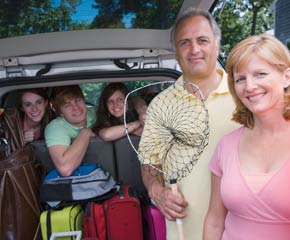Padkos
Rather than you relying on roadside nosh, pack a variety of nutritious foods in a cooler box filled with ice packs. Avoid high-sugar and refined foods. “These give you a temporary sugar-rush and then leave you feeling sluggish,” says Arrive Alive. Choose foods that help to sustain your energy and concentration levels.
Items like fresh fruits and raw vegetables, cheese or ham sandwiches on whole-wheat, individual packages of whole-wheat crackers, yoghurt and granola bars are quick and easy solutions for the road. Also, pack a few bottles of water so you don’t become tired and dehydrated while driving.
There is really no limit to what you can bring in your car. You can even go a step further and purchase a mini plug-in car fridge to help keep your food and drinks cold.
Fast food fixes
If your family stops at a Wimpy or chooses a drive-thru, try to order your hamburger without cheese, go slow on those sauces, even opt for sauce ‘on the side’, choose grilled items instead of fried, share the chips and look to the salad options, whenever possible.
Fast food or takeaways that have large surface areas like chips and chicken nuggets can absorb a fair amount of fat per portion; this increases the energy density per portion and contributes to extra kilojoules intake. Some fast-food retailers also offer larger portion sizes for little extra cost, making it easier to over-consume fat and kilojoules.
Padkos tips
Maritha Marais, Food Service Management lecturer at the Human Nutrition Division of Stellenbosch University, offers you the following food safety advice:
1. Never buy protein foods from unreliable sources. For example, if pies are being kept warm for an uncertain period of time at uncertain temperatures or sandwiches with chicken, fish or a meat filling are standing at room temperature.
2. Food should be kept piping hot or cold.
3. When packing protein-containing food items for a long trip, such as frikkadels or cold chicken, keep them very cold in a cooler box.
4. Avoid packing fish as padkos, as this is a very high-risk food.
5. Make sure protein food is cooked thoroughly, no pink juices should be visible in the middle.
6. Let food cool down to fridge temperature before packing it in well-sealed containers.
7.
Keep different kinds of food separate. Don’t put chicken, pork or beef in the same container, and also separate raw and cooked products.
8. If you keep food for longer than four hours before consumption, it may be a good idea to freeze it (if suitable for freezing) and after several hours in the cooler it will start defrosting and it might be just right to eat when you need it.
9. Try to limit the amount of times the cooler is opened. And when you do, open and close the lid quickly to help retain the temperature.

